Secrets Behind The Kangaroo Pouch: Nature's Marvel Explained
The kangaroo pouch is one of nature's most fascinating adaptations, a unique anatomical feature that allows these iconic marsupials to nurture and protect their young in an extraordinary way. This structure, which functions as a built-in nursery, highlights the incredible strategies animals have developed to ensure the survival of their offspring. Found exclusively in female kangaroos, the pouch is more than just a pocket; it's a vital part of the kangaroo's reproductive system, offering warmth, safety, and nourishment to tiny, underdeveloped joeys. But how does it work, and why is it so crucial to the kangaroo's life cycle? Let's dive into the details of this remarkable evolutionary trait.
When you think of kangaroos, the image of a joey peeking out of a pouch might instantly come to mind. However, many people don't realize the complexity and significance of the kangaroo pouch. Beyond being a snug, protective space, the pouch is a living environment that adapts to the needs of its tiny occupant. It provides a controlled microclimate, complete with sweat glands and specialized muscles, ensuring the joey's health and development. This evolutionary marvel is a testament to the ingenuity of nature and the resilience of Australia's wildlife.
In this in-depth article, we'll explore everything there is to know about the kangaroo pouch. From its anatomy and functionality to its role in the kangaroo's lifecycle, this comprehensive guide will leave no stone unturned. We'll also address frequently asked questions, debunk myths, and shed light on the lesser-known aspects of this natural wonder. So, whether you're a wildlife enthusiast, a student, or simply curious, this article will provide a wealth of information on one of nature's most intriguing features.
- Comprehensive Guide To Sigma Tau Gamma And Its Impact
- Gracia Seattle A Vibrant Hub Of Culture Community And Culinary Excellence
Table of Contents
- What is a Kangaroo Pouch?
- How Does the Kangaroo Pouch Function?
- Anatomy of the Kangaroo Pouch
- Why is the Kangaroo Pouch Important?
- What Happens Inside the Kangaroo Pouch?
- Kangaroo Reproduction and the Pouch
- How Do Joeys Use the Pouch?
- Pouch Cleanliness and Maintenance
- Differences Between Marsupial Pouches
- Kangaroo Pouch vs. Other Animals
- Evolution of the Kangaroo Pouch
- How Do Humans Study the Kangaroo Pouch?
- Frequently Asked Questions
- Conclusion
What is a Kangaroo Pouch?
The kangaroo pouch, scientifically known as the "marsupium," is a specialized fold of skin located on the abdomen of female kangaroos. It serves as a protective and nurturing space for their young, called joeys, during the early stages of their development. Unlike placental mammals, kangaroos give birth to underdeveloped offspring that complete their growth inside the pouch.
The pouch is lined with soft, hairless skin and contains mammary glands that produce milk for the growing joey. This unique feature is not only an anatomical adaptation but also a behavioral one, as kangaroos use their pouches to keep their joeys safe from predators and environmental hazards.
How Does the Kangaroo Pouch Function?
The kangaroo pouch is much more than a simple pocket. Its functionality is a result of millions of years of evolution, allowing it to meet the specific needs of both the mother and her offspring. Here are some of its key functions:
- Why Dukes In Huntington Beach Is The Ultimate Coastal Dining Experience
- Stone Harbor Golf Club A Premier Destination For Golf Enthusiasts
- Protection: The pouch shields the vulnerable joey from external dangers, including predators and harsh weather conditions.
- Nourishment: The pouch contains mammary glands that provide milk tailored to the nutritional needs of the joey at different stages of development.
- Temperature Regulation: The inside of the pouch maintains a consistent temperature, ensuring the joey's comfort and growth.
The pouch is equipped with specialized muscles that allow the mother to open and close it, preventing dirt and debris from entering while still giving the joey access when needed. This combination of protective and nurturing features makes the kangaroo pouch a true marvel of nature.
Anatomy of the Kangaroo Pouch
The anatomy of the kangaroo pouch is a masterpiece of natural engineering. Located externally on the mother's abdomen, the pouch is composed of several layers of skin and muscle that work together to create a safe and functional environment for the joey.
Why is the Kangaroo Pouch Important?
The kangaroo pouch plays a vital role in the survival and development of joeys. Without it, the young would not have the protection and resources needed to grow into independent adults. The pouch is also a key factor in the reproductive success of kangaroos, allowing mothers to care for their offspring while remaining mobile and able to forage for food.
What Happens Inside the Kangaroo Pouch?
Inside the kangaroo pouch, a fascinating process of growth and development takes place. When a joey is born, it is about the size of a jellybean and is completely dependent on its mother. It crawls into the pouch immediately after birth, where it attaches to a teat and begins to feed on milk. Over the next several months, the joey grows and gains strength, eventually venturing out of the pouch for short periods before becoming fully independent.
Kangaroo Reproduction and the Pouch
The kangaroo pouch is an integral part of the reproductive process. Female kangaroos have the unique ability to pause their pregnancy if environmental conditions are unfavorable, ensuring that their joey has the best chance of survival. This phenomenon, known as embryonic diapause, is a remarkable adaptation that highlights the importance of the pouch in the kangaroo's lifecycle.
How Do Joeys Use the Pouch?
Joeys rely on the pouch for shelter, nourishment, and protection during the early stages of their lives. They spend the first few months entirely inside the pouch, gradually venturing out as they grow. Even after they start exploring the outside world, joeys often return to the pouch for comfort and safety.
Pouch Cleanliness and Maintenance
Kangaroo mothers are meticulous about keeping their pouches clean. They often use their tongues to remove dirt and debris, ensuring a hygienic environment for their joeys. This behavior is crucial for preventing infections and maintaining the health of both the mother and her offspring.
Differences Between Marsupial Pouches
Not all marsupial pouches are created equal. While kangaroo pouches are perhaps the most well-known, other marsupials like koalas, wombats, and possums also have pouches with unique features tailored to their specific needs. Understanding these differences provides insight into the diversity of marsupial adaptations.
Kangaroo Pouch vs. Other Animals
Comparing the kangaroo pouch to similar structures in other animals highlights its uniqueness. For example, some monotremes like the platypus lack a pouch but have similar reproductive strategies, while certain reptiles and fish have evolved their own methods of protecting their young.
Evolution of the Kangaroo Pouch
The kangaroo pouch is the result of millions of years of evolution. Its development can be traced back to early marsupials, which adapted to their environments by creating a safe space for their young. This evolutionary innovation has allowed kangaroos to thrive in diverse habitats, from arid deserts to lush forests.
How Do Humans Study the Kangaroo Pouch?
Scientists study the kangaroo pouch to learn more about marsupial biology, reproduction, and evolution. Techniques such as imaging, observation, and genetic analysis have provided valuable insights into the structure and function of the pouch, helping to inform conservation efforts and medical research.
Frequently Asked Questions
1. How does a joey stay inside the pouch?
Specialized muscles in the pouch help keep the joey securely inside while allowing the mother to move freely.
2. Do male kangaroos have pouches?
No, only female kangaroos have pouches, as they are specifically designed for nurturing and protecting their young.
3. How long does a joey stay in the pouch?
Joeys typically stay in the pouch for about six to eight months before they start venturing out.
4. Can a kangaroo have more than one joey in the pouch?
While it's rare, a mother kangaroo can sometimes have two joeys of different ages in the pouch, each feeding from a different teat.
5. How do kangaroos keep their pouches clean?
Kangaroo mothers use their tongues to clean the inside of the pouch, removing dirt and debris to maintain hygiene.
6. Are there any threats to kangaroo pouches in the wild?
Environmental factors like dirt and parasites can pose risks, but kangaroo mothers are adept at keeping their pouches clean and safe.
Conclusion
The kangaroo pouch is an extraordinary adaptation that showcases the ingenuity of nature. From its intricate anatomy to its crucial role in the survival of joeys, the pouch is a marvel of evolution that continues to captivate scientists and wildlife enthusiasts alike. By understanding the kangaroo pouch, we gain not only a deeper appreciation for these iconic marsupials but also valuable insights into the wonders of the natural world.
- Comprehensive Guide To Sigma Tau Gamma And Its Impact
- The Ultimate Guide To Adam Sandler Day Outfits Tips Trends And Style

Once You See Inside A Kangaroo's Pouch, There's No Going Back The Dodo

Facts People Learned When They Were "Today Years Old" Reader's Digest